Comparing Ratios Using Ratio Tables
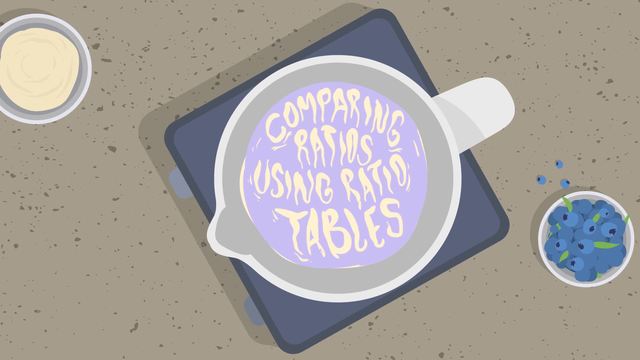

Basics on the topic Comparing Ratios Using Ratio Tables
After this lesson, you will be able to make comparisons between two or more ratios, using ratio tables and equivalent ratios.
The lesson begins by introducing a scenario involving three different ratios. It continues by outlining a strategy for comparing ratios, by finding equivalent ratios which have the same number in the same unit.
Learn about comparing ratios by figuring out who makes the fruitiest smoothie!
This video includes key concepts, notation, and vocabulary such as: ratio (a comparative, proportional relationship between two amounts); equivalent ratios (two ratios which represent the same proportional relationship); and ratio tables (a table of equivalent ratios).
Before watching this video, you should already be familiar with how to create ratio tables and sets of equivalent ratios.
After watching this video, you will be prepared to learn more techniques used to find and compare equivalent ratios.
Common Core Standard(s) in focus: 6.RP.A.3a A video intended for math students in the 6th grade Recommended for students who are 11-12 years old
Transcript Comparing Ratios Using Ratio Tables
In the summer, all across America parents are flocking to the grocery store to get ingredients for NATIONAL SMOOTHIE DAY!
This year, we're highlighting three parents whose refreshments really pack a healthy punch!
Each of the parents chooses blueberries and yogurt for their smoothies, which they combine in a special ratio.
But which of their smoothies is the fruitiest?!
Let's find out by comparing the fruit to yogurt ratios using ratio tables.
Mrs. Castenlleja always makes smoothies in a ratio of 4 cups blueberries to 7 cups yogurt.
Mr. Sweet, on the other hand, combines blueberries and yogurt in a 5 to 11 ratio, while Mrs. Harper's recipe calls for a ratio of 3 to 5.
But how do you decide whose smoothie is the fruitiest?
The fruitiest smoothie recipe is the one with the highest number of cups of blueberries compared to the number of cups of yogurt.
To make our determination, let's start with this ratio table for Mrs. Castenlleja's smoothie recipe.
If you remember, a ratio table is a table of equivalent ratios.
Notice that each of these ratios simplifies to the original we were given of 4 to 7.
Let's use this table to make a comparison with Mr. Sweet's recipe.
To find out which recipe has the highest concentration of blueberries, we can just look through the tables and try to find a pair of equivalent ratios which have the same amount of blueberries or the same amount of yogurt.
Look here: in both tables, there is a ratio which incluides 20 cups blueberries.
When Mr. Sweet uses 20 cups of blueberries, he uses 44 cups of yogurt.
Compare that to Mrs. Castenlleja, who adds 35 cups of yogurt when she uses 20 cups of blueberries.
That's 9 fewer cups of yogurt for every 20 cups of blueberries than Mr. Sweet, so Mrs. Castenlleja's smoothie is fruitier than Mr. Sweet's!
Now let's take a look at Mrs. Castenlleja's recipe and see how it stacks up against Mrs. Harper's ratio table.
Can you find where Mrs. C and Mrs. H use the same amount of blueberries or same amount of yogurt?
If you said 35 cups of yogurt, you're exactly right!
When Mrs. C uses 35 cups of yogurt, she uses 20 cups of blueberries.
While Mrs. Harper adds one more cup of blueberries when she uses the same amount of yogurt.
So Mrs. Harper's smoothies are fruitier than Mrs. Castenlleja's, and Mrs. Castenllenja's are fruitier than Mr. Sweet's, so Mrs. Harper's recipe should also be fruitier than Mr. Sweet's.
Let's check the ratio tables just to make sure.
Again, we just need to look in each table and find where the amount of blueberries or the amount of yogurt are the same.
So which ratios would YOU use to make a comparison?
Looking at the tables, Mr. Sweet and Mrs. Harper both have recipes that require 15 cups of blueberries, so let's compare those.
Mr. Sweet uses 33 cups of yogurt for every 15 cups of blueberries, and Mrs. Harper uses only 25 cups yogurt.
So which one has a higher fruit to yogurt ratio?
Since Mrs. Harper's smoothies use LESS yogurt per 15 cups blueberries, they are fruitier than Mr. Sweet's.
To double-check, we could also look at the number of cups of yogurt when making our comparison.
To do this, we need to add a few more equivalent ratios to Mrs. H's table until we find an amount that matches one of the entries in Mr. S's table.
We can do this with repeated addition by adding 3 cups of blueberries and 5 cups of yogurt.
Now we can see that when Mr. Sweet uses 55 cups of yogurt, he uses 25 cups of blueberries, and when Mrs. Harper uses 55 cups of yogurt, she uses 33 cups of blueberries.
So Mrs. Harper's smoothies ARE fruitier than Mr. Sweet's, just like we thought.
Okay, to review...
Ratio tables are a great way to find equivalent ratios and make comparisons.
To do that, look through the ratio tables that you are comparing until you find the same number in the same unit.
You can always expand the tables, if you don't find a match or if you just want to check your answer.
Just make sure that you always compare like-unit with like-unit.
So, in our examples, that meant comparing blueberries with blueberries or yogurt with yogurt.
Now, who's up for a smoothie?
Yeah...maybe National Smoothie Day isn't for everyone.
Comparing Ratios Using Ratio Tables exercise
-
Understand how to compare ratios using a ratio table.
HintsA ratio table is composed of equivalent ratios.
To compare ratios, there must be the same number in the same unit.
To determine whether something is fruitier, there must be a greater fruit to yogurt ratio than the other combination.
Solution- A ratio table is a structured list of equivalent ratios that helps us to understand the relationship between the ratios and the numbers.
- Some of the equivalent ratios in Mrs. C's table are $\frac{24}{42}$, $\frac{16}{28}$, and $\frac{8}{14}$. Each of these ratios simplifies to $\frac{4}{7}$. Simplify each ratio by dividing. For example, divide the top and bottom of $\frac{24}{42}$ by $6$ to get $\frac{4}{7}$. These are equivalent ratios. Every ratio in this table will simplify to $\frac{4}{7}$.
- Some of the ratios in Mr. S's table are $\frac{35}{77}$, $\frac{25}{55}$, and $\frac{10}{22}$. Each of these ratios simplifies to $\frac{5}{11}$. Simplify each ratio by dividing. For example, divide the top and bottom of $\frac{35}{77}$ by $7$ to get $\frac{5}{11}$. These are equivalent ratios. Every ratio in this table will simplify to $\frac{5}{11}$.
- To compare Mr. C and Mrs. S, look through the ratio tables to see where they have the same amount of blueberries or yogurt. You want to compare ratios that have the same number in the same unit.
- We can compare $\frac{20}{35}$ from Mrs. C and $\frac{20}{44}$ from Mr. S because they have the same amount of blueberries.
- These two ratios do not have the same number of cups of yogurt. Mrs. C uses $35$ cups of yogurt for $20$ blueberries, and Mr. S uses $44$ cups of yogurt for $20$ cups of blueberries.
- Mrs. C's $35$ cups of yogurt is less than Mr. S's $44$ cups of yogurt.
- So when Mrs. C and Mr. S use the same amount of blueberries, Mrs. C has the fruitier smoothie because she uses less yogurt than Mr. S.
-
Extend the ratio table in order to compare ratios.
HintsYou could use repeated addition to extend Mr. G's table.
Find ratios that have the same number in the same unit to compare.
When comparing a ratio (A) to two other ratios (B and C), first compare the ratio (A) with one of the others (B), then compare the ratio (A) with the other ratio (C).
SolutionFirst, extend Mr. G's table, one method is to use repeated addition, adding $7$ to the top row. $\begin{array}{cccccc} \text{blueberries} & 7 & 14 & 21 & 28 & 35 \\ \hline \text{yogurt} & 10 & 20 & 30 & 40 & 50\\ \end{array}$
Second, let's compare Mr. G's ratio to Mr. S's ratio.
- Find a ratio that has the same number in the same unit.
- Both Mr. G and Mr. S have $35$ cups of blueberries in one of their ratios. $\frac{35}{50}$ for Mr. G and $\frac{35}{77}$ for Mr. C.
- When they have the same number of cups of blueberries, Mr. G uses $50$ cups of yogurt and Mr. S uses $77$ cups of yogurt. $50$ is less than $77$, so Mr. G has the fruitier smoothie.
- Both Mr. G and Mrs. C have $28$ cups of blueberries in one of their ratios. $\frac{28}{40}$ for Mr. G and $\frac{28}{49}$ for Mrs. C.
- When they have the same number of cups of blueberries, Mr. G uses $40$ cups of yogurt and Mrs. C uses $49$ cups of yogurt. $40$ is less than $49$, so Mr./Mrs. G has the fruitier smoothie.
-
Identify which values can be quickly compared and pick the solution.
HintsTo compare ratios, you need the same number in the same unit.
The faster swimmer would complete more laps than the other swimmer in the same amount of time, or would complete the same amount of laps in less time.
Solution- First, decide which lap per minute ratios you can compare from John and Andrew's tables. Both tables have a $6$ in the minutes row, so we can compare $\frac{4}{6}$ from John's table and $\frac{5}{6}$ from Andrew's table.
- When comparing $\frac{4}{6}$ to $\frac{5}{6}$, both ratios have the same amount of time: minutes. The faster swimmer would complete more laps in the same amount of time. Since $5>4$, Andrew completed more laps ($5$) than John ($4$) in the same amount of time ($6$ minutes).
- Therefore, Andrew has the faster laps per minute ratio.
-
Create a ratio table and compare ratios.
HintsA ratio table is a table of equivalent ratios.
Use the ratio given to complete the table using the constant increase.
Find a ratio from each table that has the same number in the same unit, to compare the two ratios.
Solution- To complete the table for China, use the given ratio, $500$ to $1$. This ratio means that $500$ thousand metric tons of garbage is produced every day, so $1000$ thousand metric tons is produced in $2$ days, $1500$ thousand metric tons is produced in $3$ days, and so on. The complete table is below:
- Find a ratio from each table with the same value in the same unit to compare. Both tables have $2500$. The United States table has the ratio $\frac{2500}{4}$, and the China table has the ratio $\frac{2500}{5}$.
- To compare the two ratios, look at what each ratio represents. $\frac{2500}{4}$ means the United States produces $2500$ thousand metric tons of garbage in four days. $\frac{2500}{5}$ means China produces $2500$ thousand metric tons of garbage in five days.
- The question is asking you to determine which country has the least garbage production to day ratio, so you are looking for who produces the same amount of garbage in a longer period of time. It takes China five days to produce the same amount of garbage the United States produces in four days. This means that China has the least garbage production to day ratio.
-
Find the simplified ratio that describes each ratio table.
HintsAll ratios in a ratio table are equivalent.
Pick a ratio from anywhere in the table and simplify by dividing both values by their greatest common factor.
Write the ratio with the unit it represents. For example, $3$ cups of blueberries to $5$ cups of yogurt.
Solution- For the Banana Mango Smoothie, the simplified banana to mango ratio from the table is $2$ to $1$. This simplified ratio can be determined in many ways. One way is to pick a ratio from the table, for example $8$ to $4$, and simplify by dividing both values by their greatest common factor. The greatest common factor of $8$ and $4$ is $4$, so $8\div4=2$ and $4\div4=1$. This $2:1$ ratio means for every $2$ bananas you need $1$ mango.
- For the Spinach Smoothie, the ratio from the table is $3$ to $2$. This means that for every $3$ cups of spinach you need to use $2$ cups of yogurt.
- For the Strawberry Acai Smoothie, the ratio is $5$ to $4$. This means that for every $5$ packets of acai you need $4$ cups of strawberries.
-
Sort ratio tables based on speed.
HintsTo compare ratio tables, find a ratio in each table that has the same number in the same unit.
When comparing multiple ratio tables, compare two tables first, determine who is the fastest, and then compare that table with another table.
A faster cyclist will travel more miles in the same amount of time, or travel the same amount of miles in less time.
SolutionThe order of the cyclists from fastest to slowest is: Roger, Lance, Erik, Bradley.
There are many ways to find the order of the cyclists. One method is to pick two cyclists at a time to compare.
- Roger vs Bradley: Both tables have $102$ in the miles column, so you can compare Roger's $\frac{102}{3}$ to Bradley's $\frac{102}{6}$. Both cyclists traveled $102$ miles, but Roger traveled $102$ miles in less time than Bradley, so Roger is faster than Bradley.
- Roger vs. Bradley vs. Erik: All three tables have $9$ in the hours column, so you can compare Roger's $\frac{306}{9}$ to Bradley's $\frac{153}{9}$ to Erik's $\frac{180}{9}$. All three cyclists rode for the same amount of time. In that time, Roger traveled more miles than Erik, who traveled more miles than Bradley, so Roger is faster than Erik, who is faster than Bradley.
- Bradley vs. Lance: Both tables have $6$ in the hours column, so you can compare Bradley's $\frac{102}{6}$ to Lance's $\frac{180}{6}$. Both cyclists rode for the same amount of time. In that time, Lance traveled more miles than Bradley, so Lance is faster than Bradley.
- Lance vs. Erik: Both cyclists have $180$ in the miles column. Compare Lance's $\frac{180}{6}$ to Erik's $\frac{180}{9}. Both cyclists rode the same amount of miles, but Lance rode for less time than Erik, so Lance is faster than Erik.
- Lance vs. Roger: Both cyclists have $3$ in the hours column. Compare Lance's $\frac{90}{3}$ to Roger's $\frac{102}{3}$. Both cyclists traveled for the same amount of time, in that time Roger rode more miles than Lance, so Roger is faster than Lance.
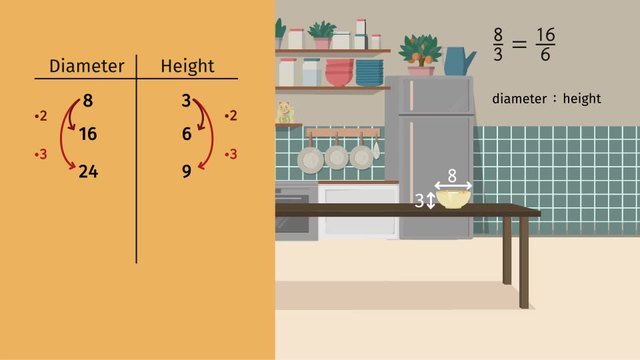
Determining Equivalent Ratios
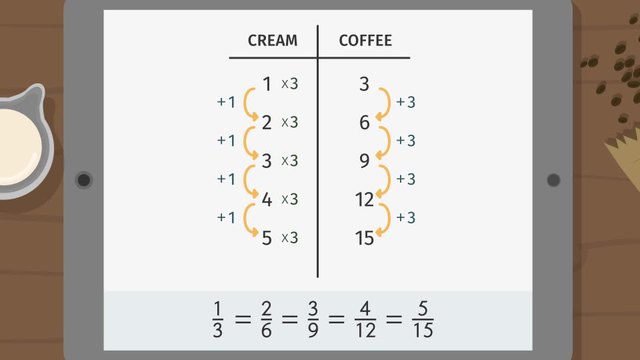
Ratio Tables - Additive and Multiplicative Structure

Comparing Ratios Using Ratio Tables
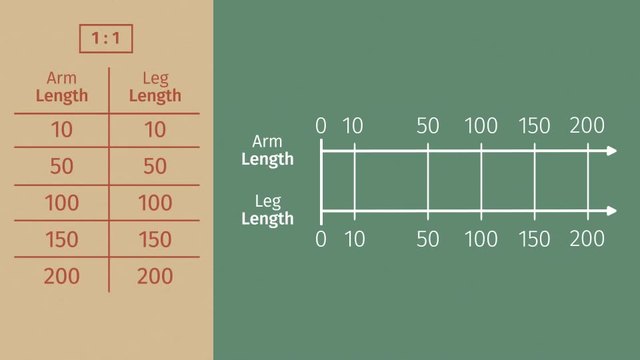
From Ratio Tables to Double Number Lines
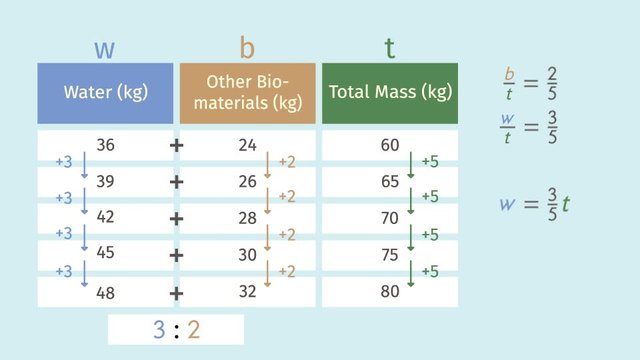
From Ratio Tables to Equations

Plotting Ratios on the Coordinate Plane
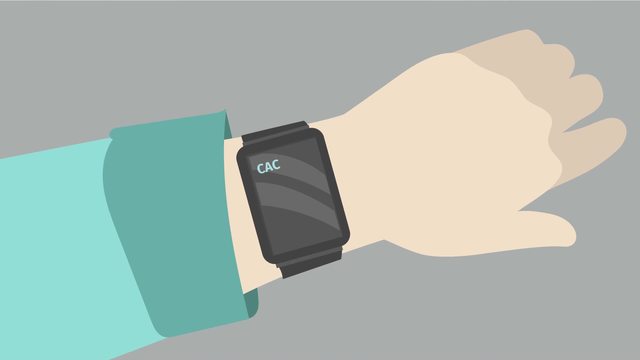
Reviewing Representations of Ratios

What are Congruence and Similarity?












yea